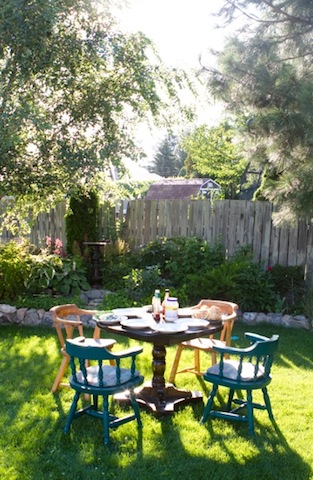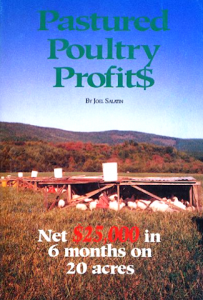
Joel Salatin believes that if we want to save the environment we need to rediscover our kitchens and learn how to cook. We will rediscover the joy of sharing meals with loved ones and value our world more. Photo courtesy of www.aholliday.com.
This last weekend I had the great pleasure of meeting Joel Salatin of Polyface Farm. He was speaking to a sold-out crowd hosted by the Cowichan Agricultural Society in Duncan, BC. Joel Salatin speaks passionately about family run, grass-based farming. In his own words, he is “in the redemption business: healing the land, healing the food, healing the economy, and healing the culture.” The guiding principles behind “Polyface are:
TRANSPARENCY: Anyone is welcome to visit the farm anytime. No trade secrets, no locked doors, every corner is camera-accessible.
GRASS-BASED: Pastured livestock and poultry, moved frequently to new “salad bars,” offer landscape healing and nutritional superiority.
INDIVIDUALITY: Plants and animals should be provided a habitat that allows them to express their physiological distinctiveness.?Respecting and honoring the pigness of the pig is a foundation for societal health.
COMMUNITY: We do not ship food.?We should all seek food closer to home, in our foodshed, our own bioregion.?This means enjoying seasonality and reacquainting ourselves with our home kitchens.
NATURE’S TEMPLATE: Mimicking natural patterns on a commercial domestic scale insures moral and ethical boundaries to human cleverness.?Cows are herbivores, not omnivores;?that is why we’ve never fed them dead cows like the United States Department of Agriculture encouraged (the alleged cause of mad cows).
EARTHWORMS: We’re really in the earthworm enhancement business.?Stimulating soil biota is our first priority.?Soil health creates healthy food.”
My husband Shaen has read most of Joel Salatin’s books, so much of the information in the lecture wasn’t new to him. Near the end of the lecture, Shaen asked Joel Salatin if there was any big differences in his thinking now compared to when he wrote his books. Joel Salatin answered that in the past he believed thousands of farmers would communicate directly with customers. But most farmers find marketing and distribution very difficult and don’t like the work. Now he sees “clusters of farms” working with “local streams of marketing and distribution”. Joel talked about a six part system for a successful local food supply: producer, processor, accountant, marketer, distributor and customer. My husband and I looked at each other and wondered if there is a place for GO BOX Storage and eatkamloops.org in this new vision.
We realized we could become a local food distribution center for Kamloops. We could form a buyer’s group for Kamloops. We could increase the size of our orders and get better prices for everyone. We could run pocket markets or personal deliveries for a cost. If you do not know about pocket markets please read:?Pocket Market Toolkit.
It was exciting thinking that we could become part of a successful local food system which helps all of us get the best in local food at a reasonable price. If we could develop a successful local food system, Joel Salatin believes “we could give the big-box stores a run for their money.”
Update November 25, 2009: I contacted Sally Fallon and asked if she knew of anyone who could mentor me to start a buyer’s group for Kamloops. She suggested John Moody who started a buyer’s club called Whole Life Buying Club. Before a new member can join the Whole Life Buying Club, they recommend the new member watch The Story of Stuff. The Whole Life Buying Club follows a Food Philosophy which defines the type of products the buying club will bring in for members. John Moody has written an essay for the journal Wise Traditions called Building a Local Food Buying Club.
Updated December 23, 2009: I have just learned from Sandra Burkholder that Joel Salatin will be coming to Quesnel, BC on March 27, 2010. Joel Salatin will be speaking at the 2nd Annual Poultry and Rabbit Forum being put on by the Cariboo Central Interior Poultry Producers Association. Sandra Burkholder and her husband Chris Newton are building a earthship house in Darfield, BC. An earthship house is made from recycled materials and is designed to be completely self-sufficient housing system requiring no outside support. The earthship is the brain child of Mike Reynolds of Earthship Biotecture.
Updated February 28, 2010: I found a series about Polyface Farm on Watch.MeetTheFarmer.TV. You will get a personal tour of Polyface Farm with Joel Salatin. There is an incredible amount of information in this video series about his pasturing systems for the watchful viewer. He will go into the types of grasses and herbage plus the effect of mass group grazing and resting of the pasture. He goes in to some theory but most of the videos are very practice. If you are interested in the theory behind his practices please read his books for more information. Here is Part I, Part II and Part III.
[The road to] hell is paved with good intentions.
English Proverbs


